Taxation Law MA613: A Comprehensive Report on SBE in Australia
VerifiedAdded on 2022/11/18
|9
|2420
|451
Report
AI Summary
This report provides a detailed analysis of Small Business Entities (SBE) in Australia, focusing on the criteria used to define them, the preferential treatment they receive from the government, and the significance of these definitions. It examines the ATO's guidelines for determining SBE eligibility, including turnover thresholds and aggregation methods, and discusses the advantages available to qualifying entities, such as CGT tax exemptions and rollovers. The report also highlights significant events and government policies affecting the tax treatment of SBEs, such as the tradies deduction and changes to the turnover threshold. Furthermore, it touches upon recent cases and announcements related to SBEs and concludes with recommendations for continued government support to attract more individuals into small business ventures. Desklib offers a wealth of resources, including similar reports and solved assignments, for students seeking to deepen their understanding of taxation law and business entities in Australia.
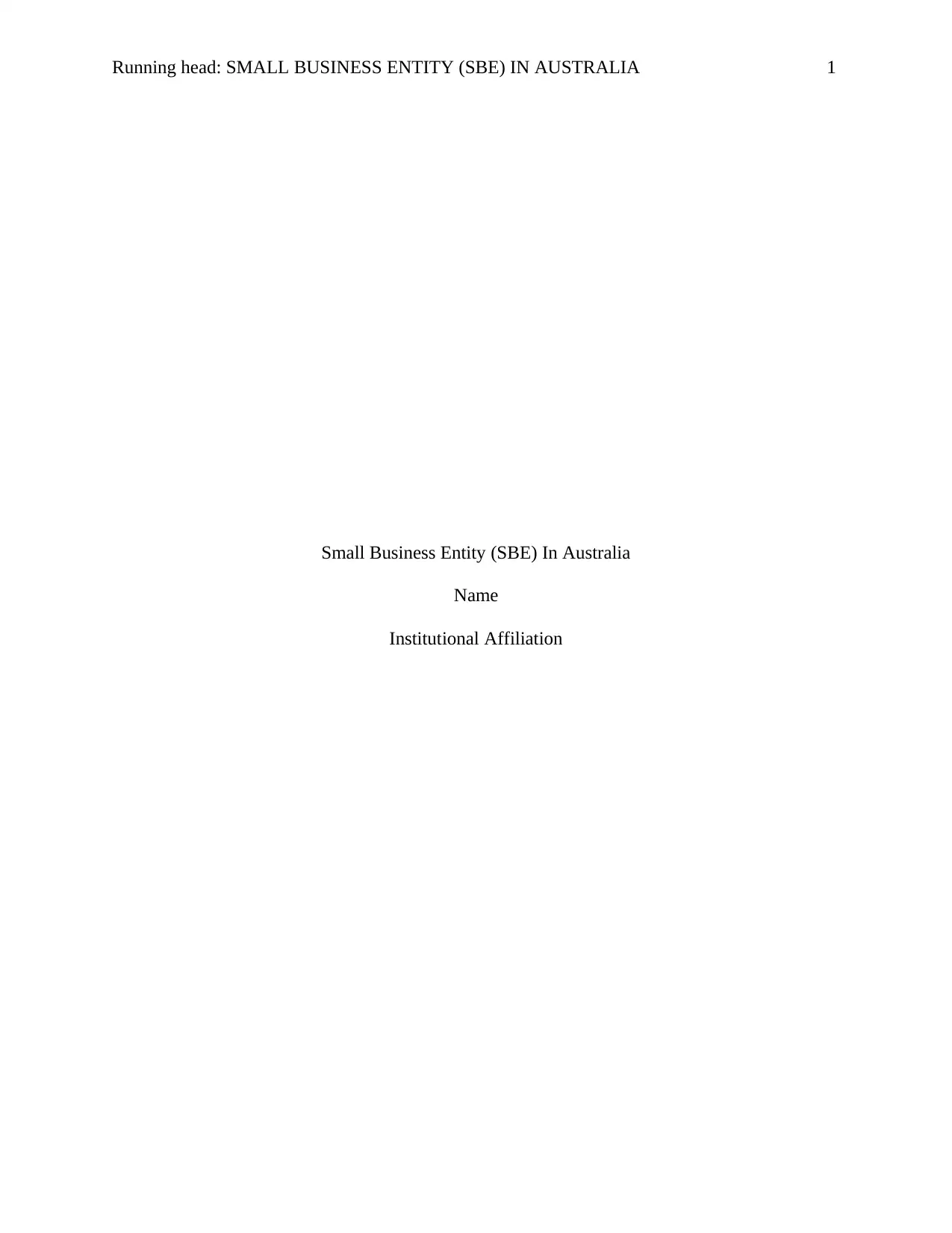
Running head: SMALL BUSINESS ENTITY (SBE) IN AUSTRALIA 1
Small Business Entity (SBE) In Australia
Name
Institutional Affiliation
Small Business Entity (SBE) In Australia
Name
Institutional Affiliation
Paraphrase This Document
Need a fresh take? Get an instant paraphrase of this document with our AI Paraphraser
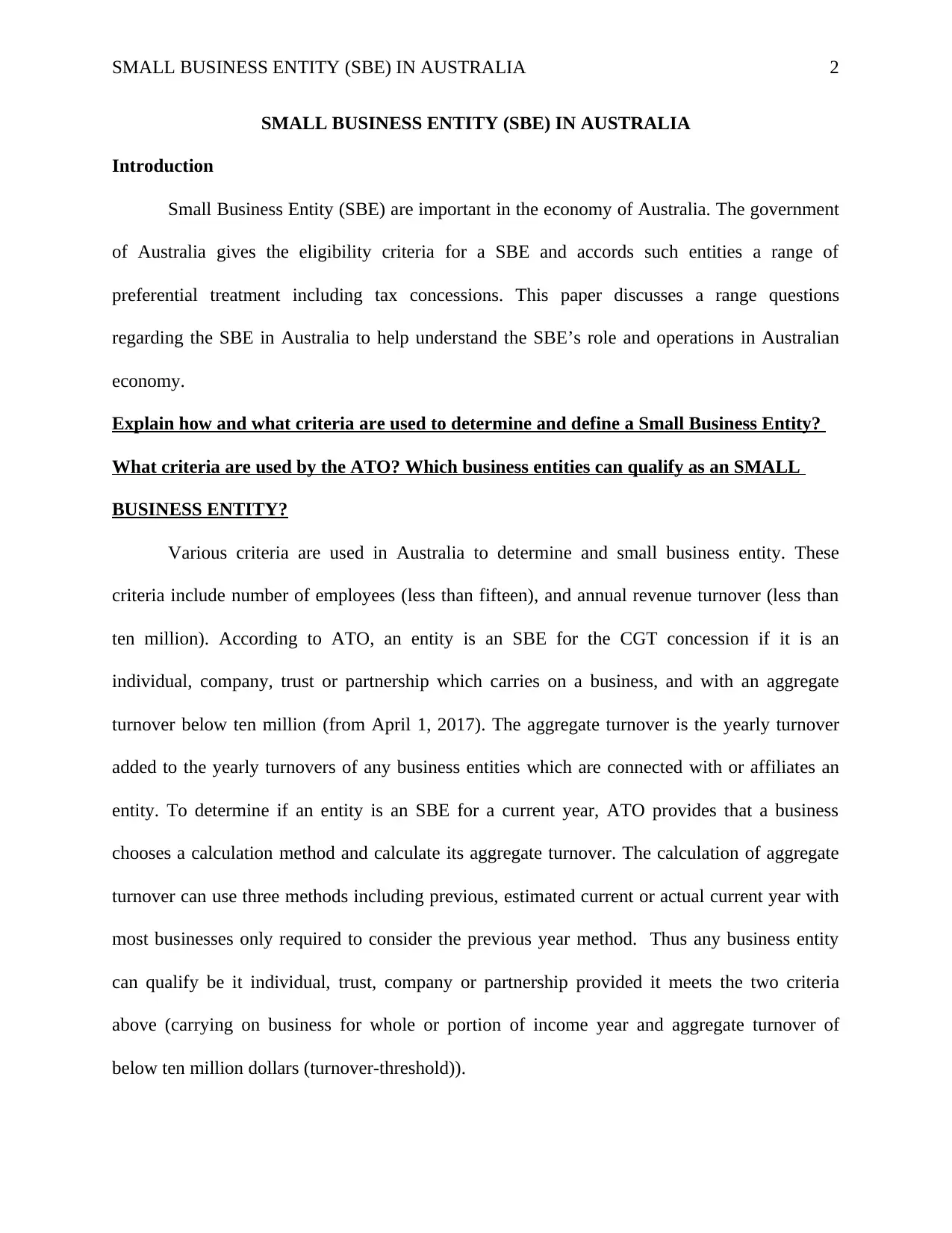
SMALL BUSINESS ENTITY (SBE) IN AUSTRALIA 2
SMALL BUSINESS ENTITY (SBE) IN AUSTRALIA
Introduction
Small Business Entity (SBE) are important in the economy of Australia. The government
of Australia gives the eligibility criteria for a SBE and accords such entities a range of
preferential treatment including tax concessions. This paper discusses a range questions
regarding the SBE in Australia to help understand the SBE’s role and operations in Australian
economy.
Explain how and what criteria are used to determine and define a Small Business Entity?
What criteria are used by the ATO? Which business entities can qualify as an SMALL
BUSINESS ENTITY?
Various criteria are used in Australia to determine and small business entity. These
criteria include number of employees (less than fifteen), and annual revenue turnover (less than
ten million). According to ATO, an entity is an SBE for the CGT concession if it is an
individual, company, trust or partnership which carries on a business, and with an aggregate
turnover below ten million (from April 1, 2017). The aggregate turnover is the yearly turnover
added to the yearly turnovers of any business entities which are connected with or affiliates an
entity. To determine if an entity is an SBE for a current year, ATO provides that a business
chooses a calculation method and calculate its aggregate turnover. The calculation of aggregate
turnover can use three methods including previous, estimated current or actual current year with
most businesses only required to consider the previous year method. Thus any business entity
can qualify be it individual, trust, company or partnership provided it meets the two criteria
above (carrying on business for whole or portion of income year and aggregate turnover of
below ten million dollars (turnover-threshold)).
SMALL BUSINESS ENTITY (SBE) IN AUSTRALIA
Introduction
Small Business Entity (SBE) are important in the economy of Australia. The government
of Australia gives the eligibility criteria for a SBE and accords such entities a range of
preferential treatment including tax concessions. This paper discusses a range questions
regarding the SBE in Australia to help understand the SBE’s role and operations in Australian
economy.
Explain how and what criteria are used to determine and define a Small Business Entity?
What criteria are used by the ATO? Which business entities can qualify as an SMALL
BUSINESS ENTITY?
Various criteria are used in Australia to determine and small business entity. These
criteria include number of employees (less than fifteen), and annual revenue turnover (less than
ten million). According to ATO, an entity is an SBE for the CGT concession if it is an
individual, company, trust or partnership which carries on a business, and with an aggregate
turnover below ten million (from April 1, 2017). The aggregate turnover is the yearly turnover
added to the yearly turnovers of any business entities which are connected with or affiliates an
entity. To determine if an entity is an SBE for a current year, ATO provides that a business
chooses a calculation method and calculate its aggregate turnover. The calculation of aggregate
turnover can use three methods including previous, estimated current or actual current year with
most businesses only required to consider the previous year method. Thus any business entity
can qualify be it individual, trust, company or partnership provided it meets the two criteria
above (carrying on business for whole or portion of income year and aggregate turnover of
below ten million dollars (turnover-threshold)).
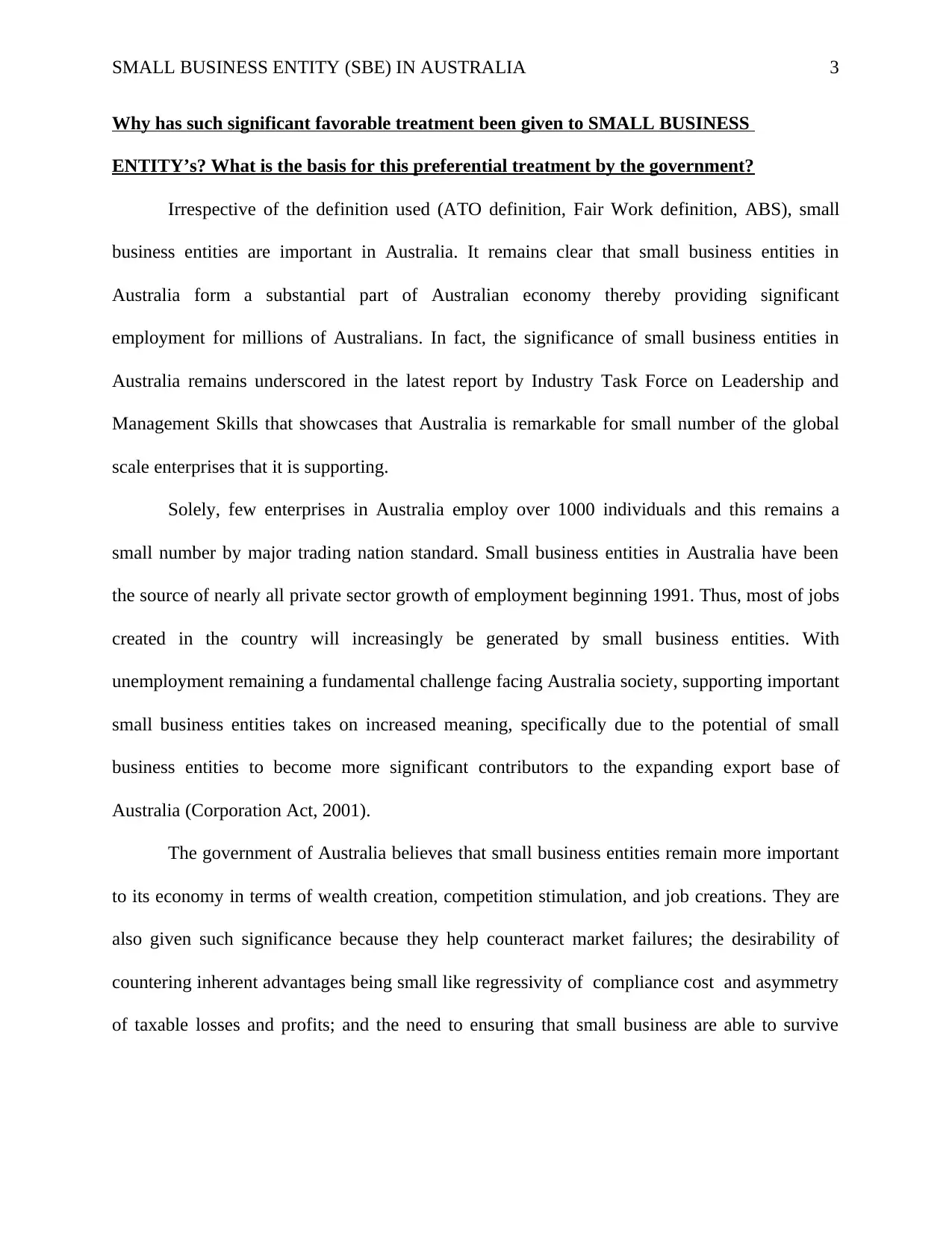
SMALL BUSINESS ENTITY (SBE) IN AUSTRALIA 3
Why has such significant favorable treatment been given to SMALL BUSINESS
ENTITY’s? What is the basis for this preferential treatment by the government?
Irrespective of the definition used (ATO definition, Fair Work definition, ABS), small
business entities are important in Australia. It remains clear that small business entities in
Australia form a substantial part of Australian economy thereby providing significant
employment for millions of Australians. In fact, the significance of small business entities in
Australia remains underscored in the latest report by Industry Task Force on Leadership and
Management Skills that showcases that Australia is remarkable for small number of the global
scale enterprises that it is supporting.
Solely, few enterprises in Australia employ over 1000 individuals and this remains a
small number by major trading nation standard. Small business entities in Australia have been
the source of nearly all private sector growth of employment beginning 1991. Thus, most of jobs
created in the country will increasingly be generated by small business entities. With
unemployment remaining a fundamental challenge facing Australia society, supporting important
small business entities takes on increased meaning, specifically due to the potential of small
business entities to become more significant contributors to the expanding export base of
Australia (Corporation Act, 2001).
The government of Australia believes that small business entities remain more important
to its economy in terms of wealth creation, competition stimulation, and job creations. They are
also given such significance because they help counteract market failures; the desirability of
countering inherent advantages being small like regressivity of compliance cost and asymmetry
of taxable losses and profits; and the need to ensuring that small business are able to survive
Why has such significant favorable treatment been given to SMALL BUSINESS
ENTITY’s? What is the basis for this preferential treatment by the government?
Irrespective of the definition used (ATO definition, Fair Work definition, ABS), small
business entities are important in Australia. It remains clear that small business entities in
Australia form a substantial part of Australian economy thereby providing significant
employment for millions of Australians. In fact, the significance of small business entities in
Australia remains underscored in the latest report by Industry Task Force on Leadership and
Management Skills that showcases that Australia is remarkable for small number of the global
scale enterprises that it is supporting.
Solely, few enterprises in Australia employ over 1000 individuals and this remains a
small number by major trading nation standard. Small business entities in Australia have been
the source of nearly all private sector growth of employment beginning 1991. Thus, most of jobs
created in the country will increasingly be generated by small business entities. With
unemployment remaining a fundamental challenge facing Australia society, supporting important
small business entities takes on increased meaning, specifically due to the potential of small
business entities to become more significant contributors to the expanding export base of
Australia (Corporation Act, 2001).
The government of Australia believes that small business entities remain more important
to its economy in terms of wealth creation, competition stimulation, and job creations. They are
also given such significance because they help counteract market failures; the desirability of
countering inherent advantages being small like regressivity of compliance cost and asymmetry
of taxable losses and profits; and the need to ensuring that small business are able to survive
⊘ This is a preview!⊘
Do you want full access?
Subscribe today to unlock all pages.

Trusted by 1+ million students worldwide
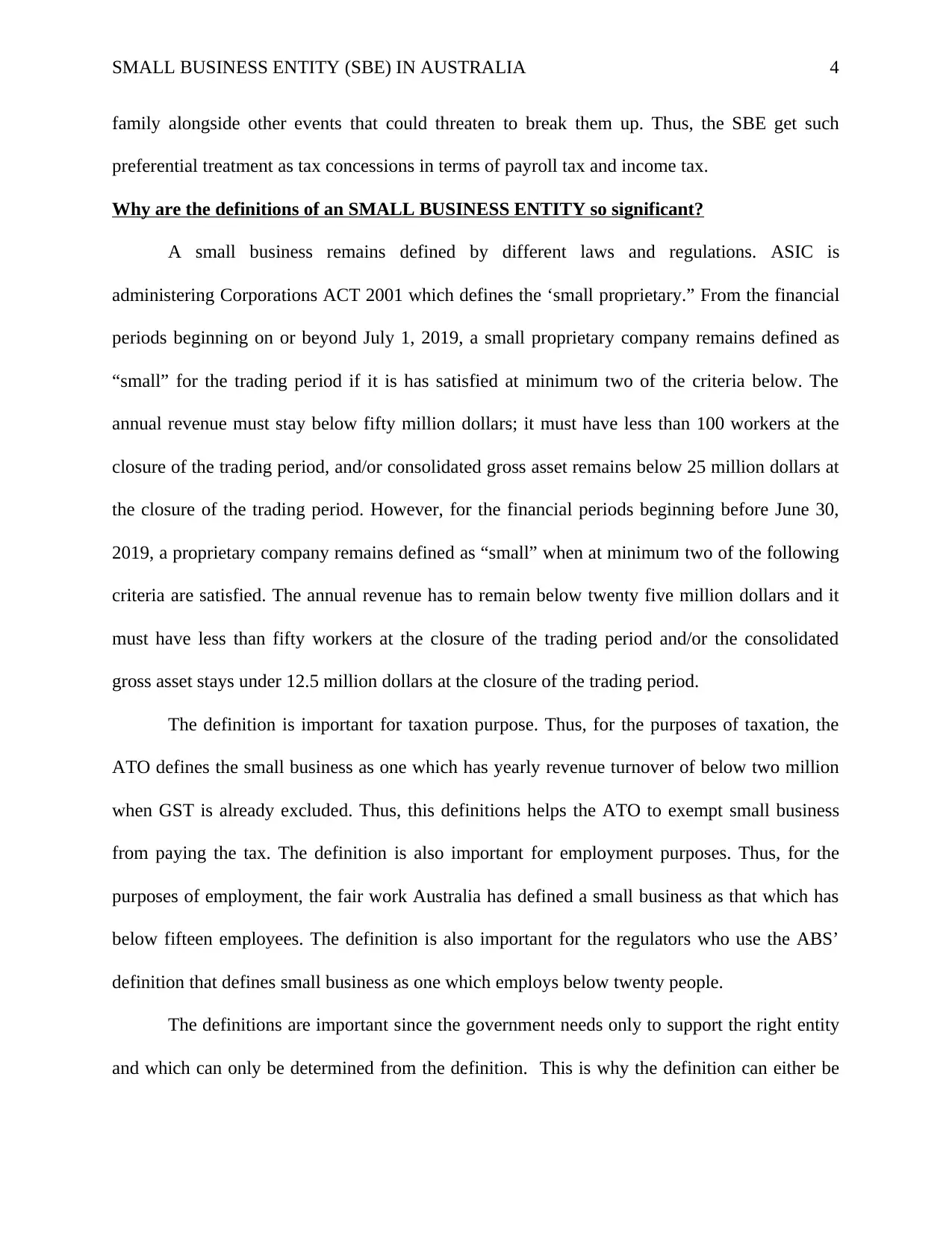
SMALL BUSINESS ENTITY (SBE) IN AUSTRALIA 4
family alongside other events that could threaten to break them up. Thus, the SBE get such
preferential treatment as tax concessions in terms of payroll tax and income tax.
Why are the definitions of an SMALL BUSINESS ENTITY so significant?
A small business remains defined by different laws and regulations. ASIC is
administering Corporations ACT 2001 which defines the ‘small proprietary.” From the financial
periods beginning on or beyond July 1, 2019, a small proprietary company remains defined as
“small” for the trading period if it is has satisfied at minimum two of the criteria below. The
annual revenue must stay below fifty million dollars; it must have less than 100 workers at the
closure of the trading period, and/or consolidated gross asset remains below 25 million dollars at
the closure of the trading period. However, for the financial periods beginning before June 30,
2019, a proprietary company remains defined as “small” when at minimum two of the following
criteria are satisfied. The annual revenue has to remain below twenty five million dollars and it
must have less than fifty workers at the closure of the trading period and/or the consolidated
gross asset stays under 12.5 million dollars at the closure of the trading period.
The definition is important for taxation purpose. Thus, for the purposes of taxation, the
ATO defines the small business as one which has yearly revenue turnover of below two million
when GST is already excluded. Thus, this definitions helps the ATO to exempt small business
from paying the tax. The definition is also important for employment purposes. Thus, for the
purposes of employment, the fair work Australia has defined a small business as that which has
below fifteen employees. The definition is also important for the regulators who use the ABS’
definition that defines small business as one which employs below twenty people.
The definitions are important since the government needs only to support the right entity
and which can only be determined from the definition. This is why the definition can either be
family alongside other events that could threaten to break them up. Thus, the SBE get such
preferential treatment as tax concessions in terms of payroll tax and income tax.
Why are the definitions of an SMALL BUSINESS ENTITY so significant?
A small business remains defined by different laws and regulations. ASIC is
administering Corporations ACT 2001 which defines the ‘small proprietary.” From the financial
periods beginning on or beyond July 1, 2019, a small proprietary company remains defined as
“small” for the trading period if it is has satisfied at minimum two of the criteria below. The
annual revenue must stay below fifty million dollars; it must have less than 100 workers at the
closure of the trading period, and/or consolidated gross asset remains below 25 million dollars at
the closure of the trading period. However, for the financial periods beginning before June 30,
2019, a proprietary company remains defined as “small” when at minimum two of the following
criteria are satisfied. The annual revenue has to remain below twenty five million dollars and it
must have less than fifty workers at the closure of the trading period and/or the consolidated
gross asset stays under 12.5 million dollars at the closure of the trading period.
The definition is important for taxation purpose. Thus, for the purposes of taxation, the
ATO defines the small business as one which has yearly revenue turnover of below two million
when GST is already excluded. Thus, this definitions helps the ATO to exempt small business
from paying the tax. The definition is also important for employment purposes. Thus, for the
purposes of employment, the fair work Australia has defined a small business as that which has
below fifteen employees. The definition is also important for the regulators who use the ABS’
definition that defines small business as one which employs below twenty people.
The definitions are important since the government needs only to support the right entity
and which can only be determined from the definition. This is why the definition can either be
Paraphrase This Document
Need a fresh take? Get an instant paraphrase of this document with our AI Paraphraser
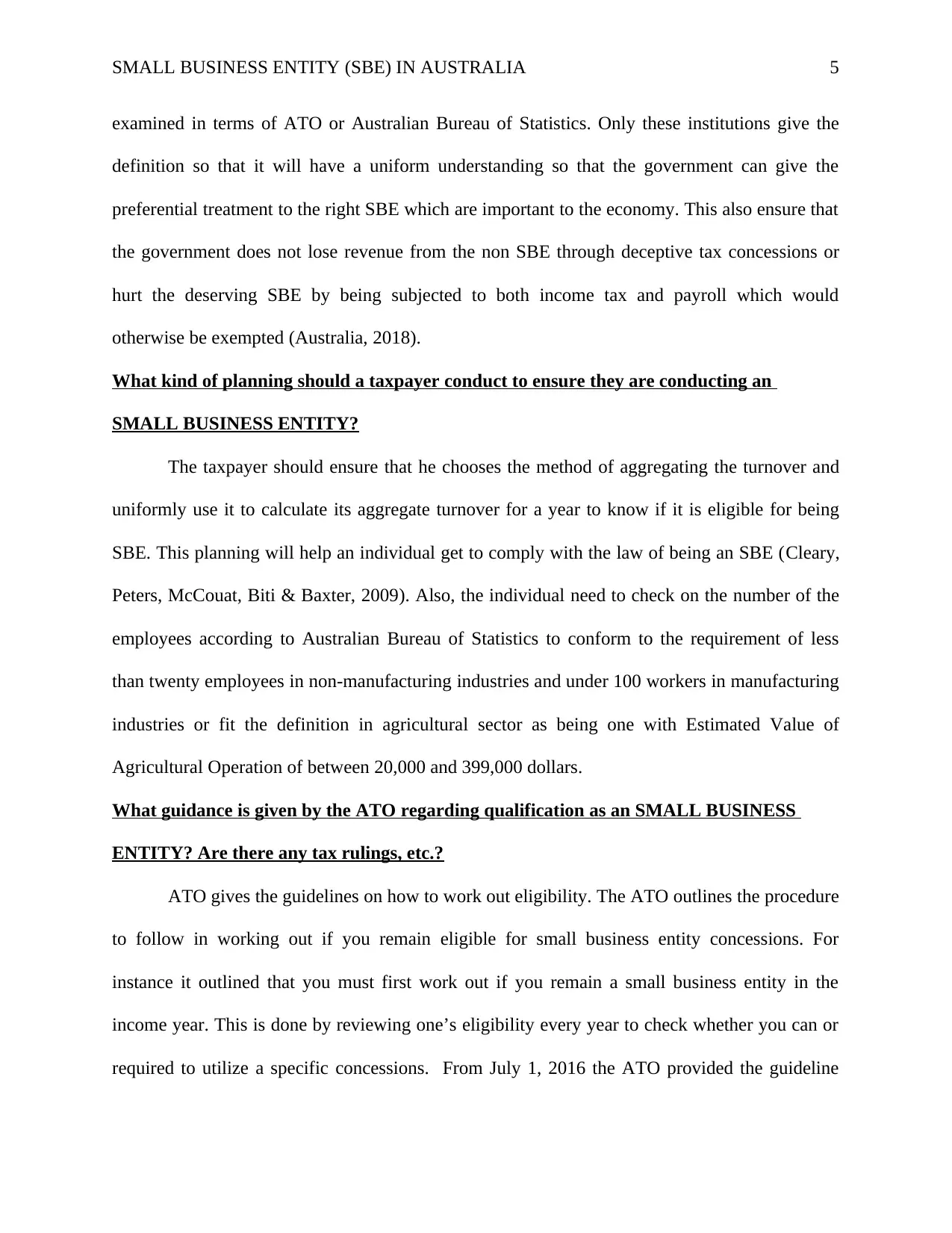
SMALL BUSINESS ENTITY (SBE) IN AUSTRALIA 5
examined in terms of ATO or Australian Bureau of Statistics. Only these institutions give the
definition so that it will have a uniform understanding so that the government can give the
preferential treatment to the right SBE which are important to the economy. This also ensure that
the government does not lose revenue from the non SBE through deceptive tax concessions or
hurt the deserving SBE by being subjected to both income tax and payroll which would
otherwise be exempted (Australia, 2018).
What kind of planning should a taxpayer conduct to ensure they are conducting an
SMALL BUSINESS ENTITY?
The taxpayer should ensure that he chooses the method of aggregating the turnover and
uniformly use it to calculate its aggregate turnover for a year to know if it is eligible for being
SBE. This planning will help an individual get to comply with the law of being an SBE (Cleary,
Peters, McCouat, Biti & Baxter, 2009). Also, the individual need to check on the number of the
employees according to Australian Bureau of Statistics to conform to the requirement of less
than twenty employees in non-manufacturing industries and under 100 workers in manufacturing
industries or fit the definition in agricultural sector as being one with Estimated Value of
Agricultural Operation of between 20,000 and 399,000 dollars.
What guidance is given by the ATO regarding qualification as an SMALL BUSINESS
ENTITY? Are there any tax rulings, etc.?
ATO gives the guidelines on how to work out eligibility. The ATO outlines the procedure
to follow in working out if you remain eligible for small business entity concessions. For
instance it outlined that you must first work out if you remain a small business entity in the
income year. This is done by reviewing one’s eligibility every year to check whether you can or
required to utilize a specific concessions. From July 1, 2016 the ATO provided the guideline
examined in terms of ATO or Australian Bureau of Statistics. Only these institutions give the
definition so that it will have a uniform understanding so that the government can give the
preferential treatment to the right SBE which are important to the economy. This also ensure that
the government does not lose revenue from the non SBE through deceptive tax concessions or
hurt the deserving SBE by being subjected to both income tax and payroll which would
otherwise be exempted (Australia, 2018).
What kind of planning should a taxpayer conduct to ensure they are conducting an
SMALL BUSINESS ENTITY?
The taxpayer should ensure that he chooses the method of aggregating the turnover and
uniformly use it to calculate its aggregate turnover for a year to know if it is eligible for being
SBE. This planning will help an individual get to comply with the law of being an SBE (Cleary,
Peters, McCouat, Biti & Baxter, 2009). Also, the individual need to check on the number of the
employees according to Australian Bureau of Statistics to conform to the requirement of less
than twenty employees in non-manufacturing industries and under 100 workers in manufacturing
industries or fit the definition in agricultural sector as being one with Estimated Value of
Agricultural Operation of between 20,000 and 399,000 dollars.
What guidance is given by the ATO regarding qualification as an SMALL BUSINESS
ENTITY? Are there any tax rulings, etc.?
ATO gives the guidelines on how to work out eligibility. The ATO outlines the procedure
to follow in working out if you remain eligible for small business entity concessions. For
instance it outlined that you must first work out if you remain a small business entity in the
income year. This is done by reviewing one’s eligibility every year to check whether you can or
required to utilize a specific concessions. From July 1, 2016 the ATO provided the guideline
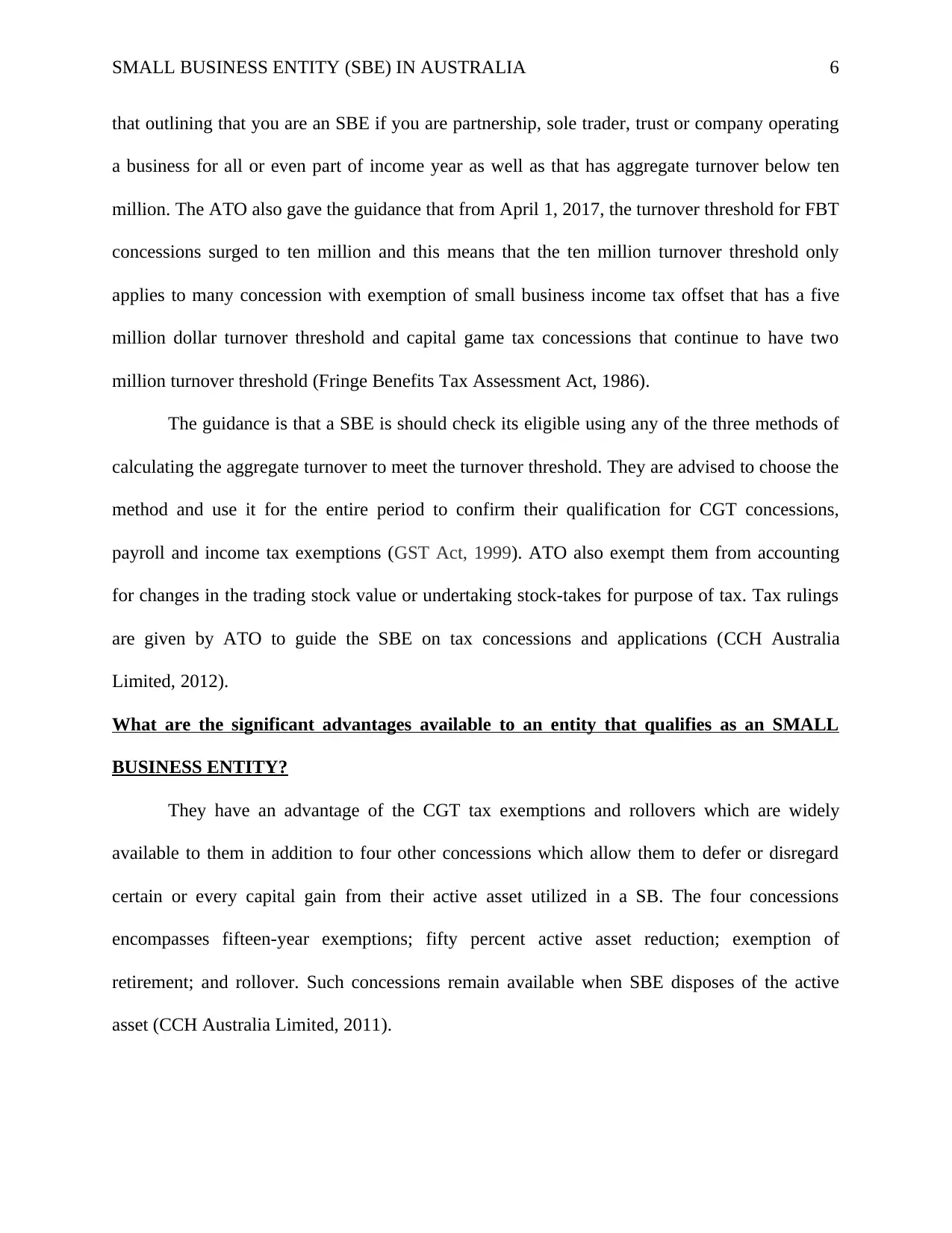
SMALL BUSINESS ENTITY (SBE) IN AUSTRALIA 6
that outlining that you are an SBE if you are partnership, sole trader, trust or company operating
a business for all or even part of income year as well as that has aggregate turnover below ten
million. The ATO also gave the guidance that from April 1, 2017, the turnover threshold for FBT
concessions surged to ten million and this means that the ten million turnover threshold only
applies to many concession with exemption of small business income tax offset that has a five
million dollar turnover threshold and capital game tax concessions that continue to have two
million turnover threshold (Fringe Benefits Tax Assessment Act, 1986).
The guidance is that a SBE is should check its eligible using any of the three methods of
calculating the aggregate turnover to meet the turnover threshold. They are advised to choose the
method and use it for the entire period to confirm their qualification for CGT concessions,
payroll and income tax exemptions (GST Act, 1999). ATO also exempt them from accounting
for changes in the trading stock value or undertaking stock-takes for purpose of tax. Tax rulings
are given by ATO to guide the SBE on tax concessions and applications (CCH Australia
Limited, 2012).
What are the significant advantages available to an entity that qualifies as an SMALL
BUSINESS ENTITY?
They have an advantage of the CGT tax exemptions and rollovers which are widely
available to them in addition to four other concessions which allow them to defer or disregard
certain or every capital gain from their active asset utilized in a SB. The four concessions
encompasses fifteen-year exemptions; fifty percent active asset reduction; exemption of
retirement; and rollover. Such concessions remain available when SBE disposes of the active
asset (CCH Australia Limited, 2011).
that outlining that you are an SBE if you are partnership, sole trader, trust or company operating
a business for all or even part of income year as well as that has aggregate turnover below ten
million. The ATO also gave the guidance that from April 1, 2017, the turnover threshold for FBT
concessions surged to ten million and this means that the ten million turnover threshold only
applies to many concession with exemption of small business income tax offset that has a five
million dollar turnover threshold and capital game tax concessions that continue to have two
million turnover threshold (Fringe Benefits Tax Assessment Act, 1986).
The guidance is that a SBE is should check its eligible using any of the three methods of
calculating the aggregate turnover to meet the turnover threshold. They are advised to choose the
method and use it for the entire period to confirm their qualification for CGT concessions,
payroll and income tax exemptions (GST Act, 1999). ATO also exempt them from accounting
for changes in the trading stock value or undertaking stock-takes for purpose of tax. Tax rulings
are given by ATO to guide the SBE on tax concessions and applications (CCH Australia
Limited, 2012).
What are the significant advantages available to an entity that qualifies as an SMALL
BUSINESS ENTITY?
They have an advantage of the CGT tax exemptions and rollovers which are widely
available to them in addition to four other concessions which allow them to defer or disregard
certain or every capital gain from their active asset utilized in a SB. The four concessions
encompasses fifteen-year exemptions; fifty percent active asset reduction; exemption of
retirement; and rollover. Such concessions remain available when SBE disposes of the active
asset (CCH Australia Limited, 2011).
⊘ This is a preview!⊘
Do you want full access?
Subscribe today to unlock all pages.

Trusted by 1+ million students worldwide
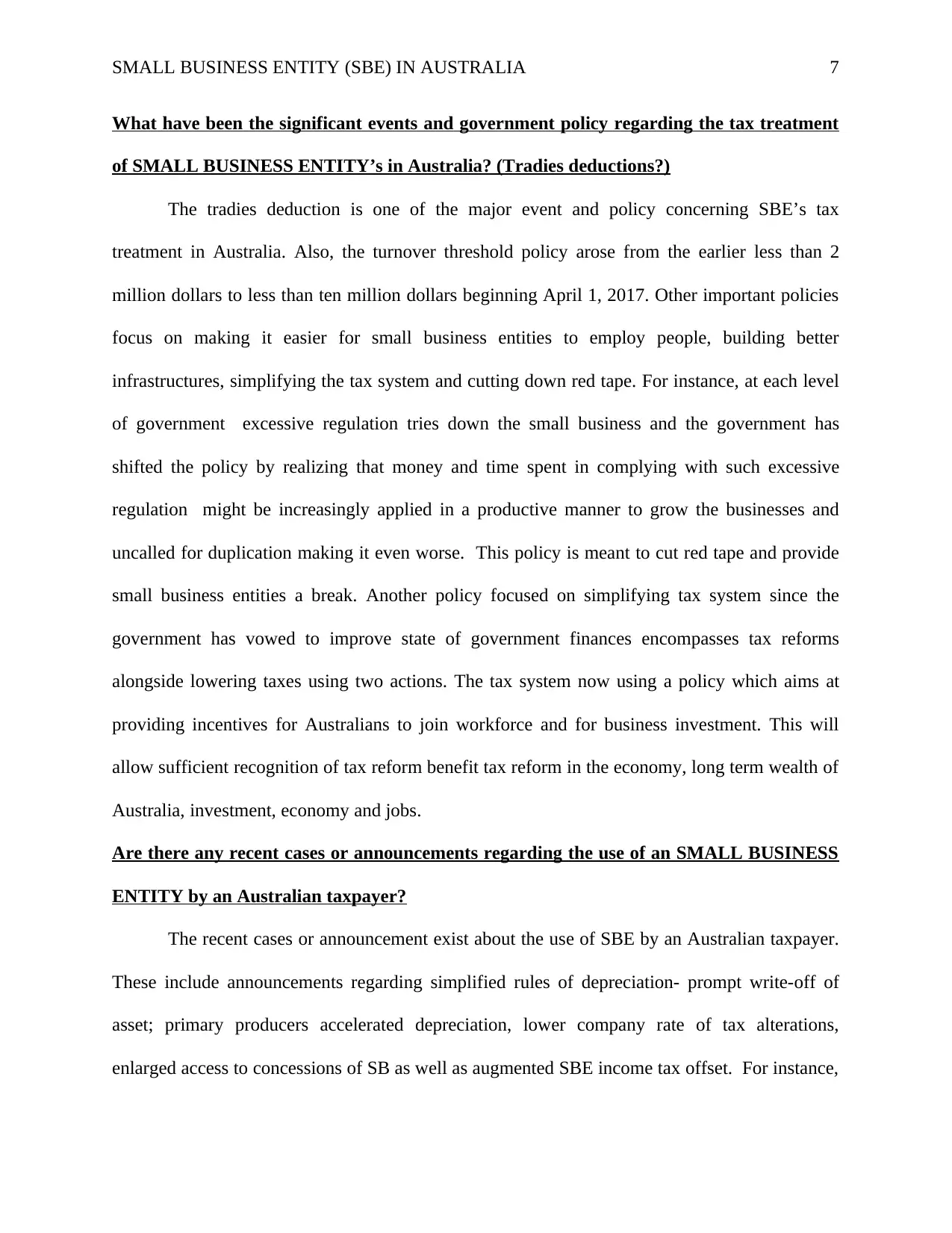
SMALL BUSINESS ENTITY (SBE) IN AUSTRALIA 7
What have been the significant events and government policy regarding the tax treatment
of SMALL BUSINESS ENTITY’s in Australia? (Tradies deductions?)
The tradies deduction is one of the major event and policy concerning SBE’s tax
treatment in Australia. Also, the turnover threshold policy arose from the earlier less than 2
million dollars to less than ten million dollars beginning April 1, 2017. Other important policies
focus on making it easier for small business entities to employ people, building better
infrastructures, simplifying the tax system and cutting down red tape. For instance, at each level
of government excessive regulation tries down the small business and the government has
shifted the policy by realizing that money and time spent in complying with such excessive
regulation might be increasingly applied in a productive manner to grow the businesses and
uncalled for duplication making it even worse. This policy is meant to cut red tape and provide
small business entities a break. Another policy focused on simplifying tax system since the
government has vowed to improve state of government finances encompasses tax reforms
alongside lowering taxes using two actions. The tax system now using a policy which aims at
providing incentives for Australians to join workforce and for business investment. This will
allow sufficient recognition of tax reform benefit tax reform in the economy, long term wealth of
Australia, investment, economy and jobs.
Are there any recent cases or announcements regarding the use of an SMALL BUSINESS
ENTITY by an Australian taxpayer?
The recent cases or announcement exist about the use of SBE by an Australian taxpayer.
These include announcements regarding simplified rules of depreciation- prompt write-off of
asset; primary producers accelerated depreciation, lower company rate of tax alterations,
enlarged access to concessions of SB as well as augmented SBE income tax offset. For instance,
What have been the significant events and government policy regarding the tax treatment
of SMALL BUSINESS ENTITY’s in Australia? (Tradies deductions?)
The tradies deduction is one of the major event and policy concerning SBE’s tax
treatment in Australia. Also, the turnover threshold policy arose from the earlier less than 2
million dollars to less than ten million dollars beginning April 1, 2017. Other important policies
focus on making it easier for small business entities to employ people, building better
infrastructures, simplifying the tax system and cutting down red tape. For instance, at each level
of government excessive regulation tries down the small business and the government has
shifted the policy by realizing that money and time spent in complying with such excessive
regulation might be increasingly applied in a productive manner to grow the businesses and
uncalled for duplication making it even worse. This policy is meant to cut red tape and provide
small business entities a break. Another policy focused on simplifying tax system since the
government has vowed to improve state of government finances encompasses tax reforms
alongside lowering taxes using two actions. The tax system now using a policy which aims at
providing incentives for Australians to join workforce and for business investment. This will
allow sufficient recognition of tax reform benefit tax reform in the economy, long term wealth of
Australia, investment, economy and jobs.
Are there any recent cases or announcements regarding the use of an SMALL BUSINESS
ENTITY by an Australian taxpayer?
The recent cases or announcement exist about the use of SBE by an Australian taxpayer.
These include announcements regarding simplified rules of depreciation- prompt write-off of
asset; primary producers accelerated depreciation, lower company rate of tax alterations,
enlarged access to concessions of SB as well as augmented SBE income tax offset. For instance,
Paraphrase This Document
Need a fresh take? Get an instant paraphrase of this document with our AI Paraphraser
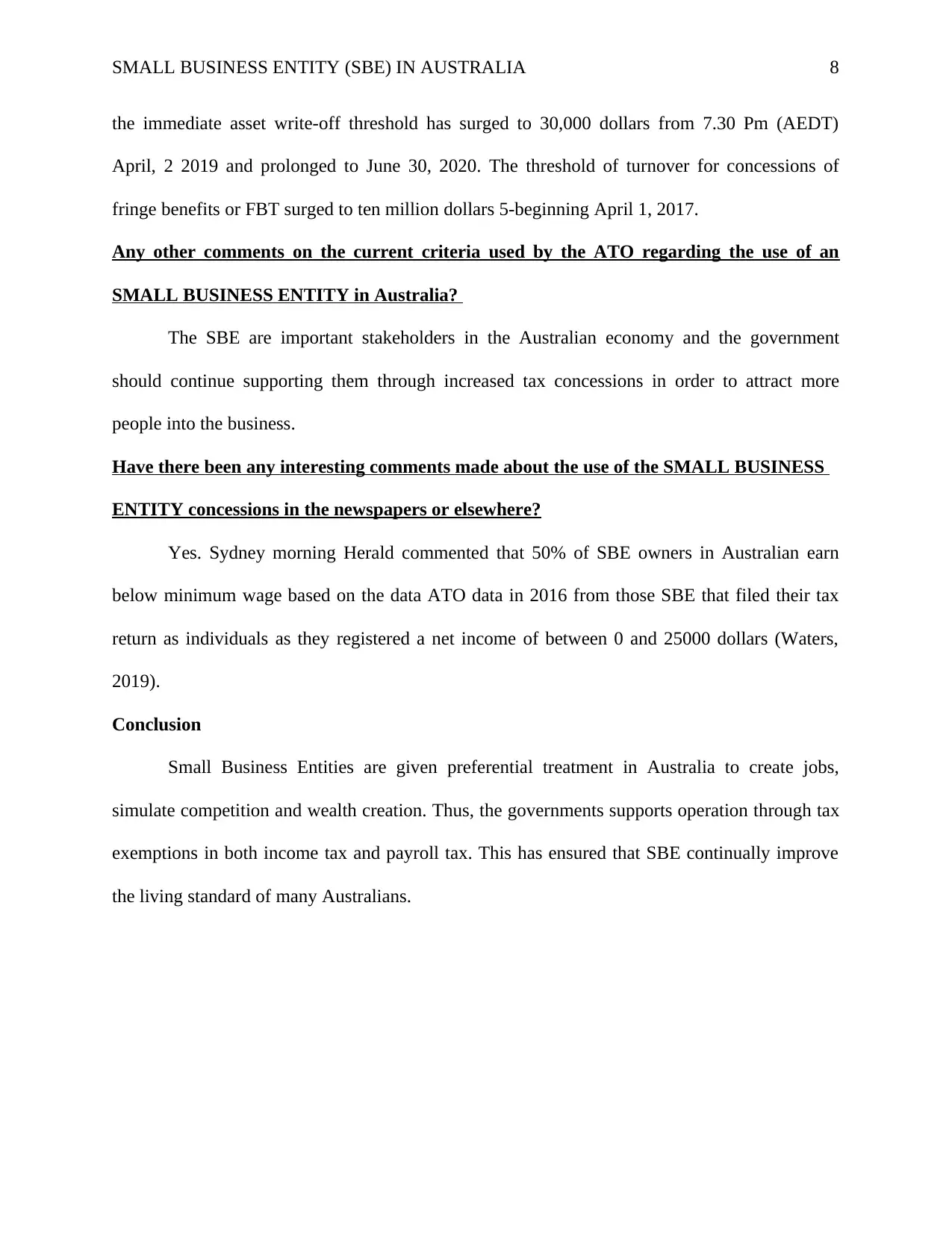
SMALL BUSINESS ENTITY (SBE) IN AUSTRALIA 8
the immediate asset write-off threshold has surged to 30,000 dollars from 7.30 Pm (AEDT)
April, 2 2019 and prolonged to June 30, 2020. The threshold of turnover for concessions of
fringe benefits or FBT surged to ten million dollars 5-beginning April 1, 2017.
Any other comments on the current criteria used by the ATO regarding the use of an
SMALL BUSINESS ENTITY in Australia?
The SBE are important stakeholders in the Australian economy and the government
should continue supporting them through increased tax concessions in order to attract more
people into the business.
Have there been any interesting comments made about the use of the SMALL BUSINESS
ENTITY concessions in the newspapers or elsewhere?
Yes. Sydney morning Herald commented that 50% of SBE owners in Australian earn
below minimum wage based on the data ATO data in 2016 from those SBE that filed their tax
return as individuals as they registered a net income of between 0 and 25000 dollars (Waters,
2019).
Conclusion
Small Business Entities are given preferential treatment in Australia to create jobs,
simulate competition and wealth creation. Thus, the governments supports operation through tax
exemptions in both income tax and payroll tax. This has ensured that SBE continually improve
the living standard of many Australians.
the immediate asset write-off threshold has surged to 30,000 dollars from 7.30 Pm (AEDT)
April, 2 2019 and prolonged to June 30, 2020. The threshold of turnover for concessions of
fringe benefits or FBT surged to ten million dollars 5-beginning April 1, 2017.
Any other comments on the current criteria used by the ATO regarding the use of an
SMALL BUSINESS ENTITY in Australia?
The SBE are important stakeholders in the Australian economy and the government
should continue supporting them through increased tax concessions in order to attract more
people into the business.
Have there been any interesting comments made about the use of the SMALL BUSINESS
ENTITY concessions in the newspapers or elsewhere?
Yes. Sydney morning Herald commented that 50% of SBE owners in Australian earn
below minimum wage based on the data ATO data in 2016 from those SBE that filed their tax
return as individuals as they registered a net income of between 0 and 25000 dollars (Waters,
2019).
Conclusion
Small Business Entities are given preferential treatment in Australia to create jobs,
simulate competition and wealth creation. Thus, the governments supports operation through tax
exemptions in both income tax and payroll tax. This has ensured that SBE continually improve
the living standard of many Australians.
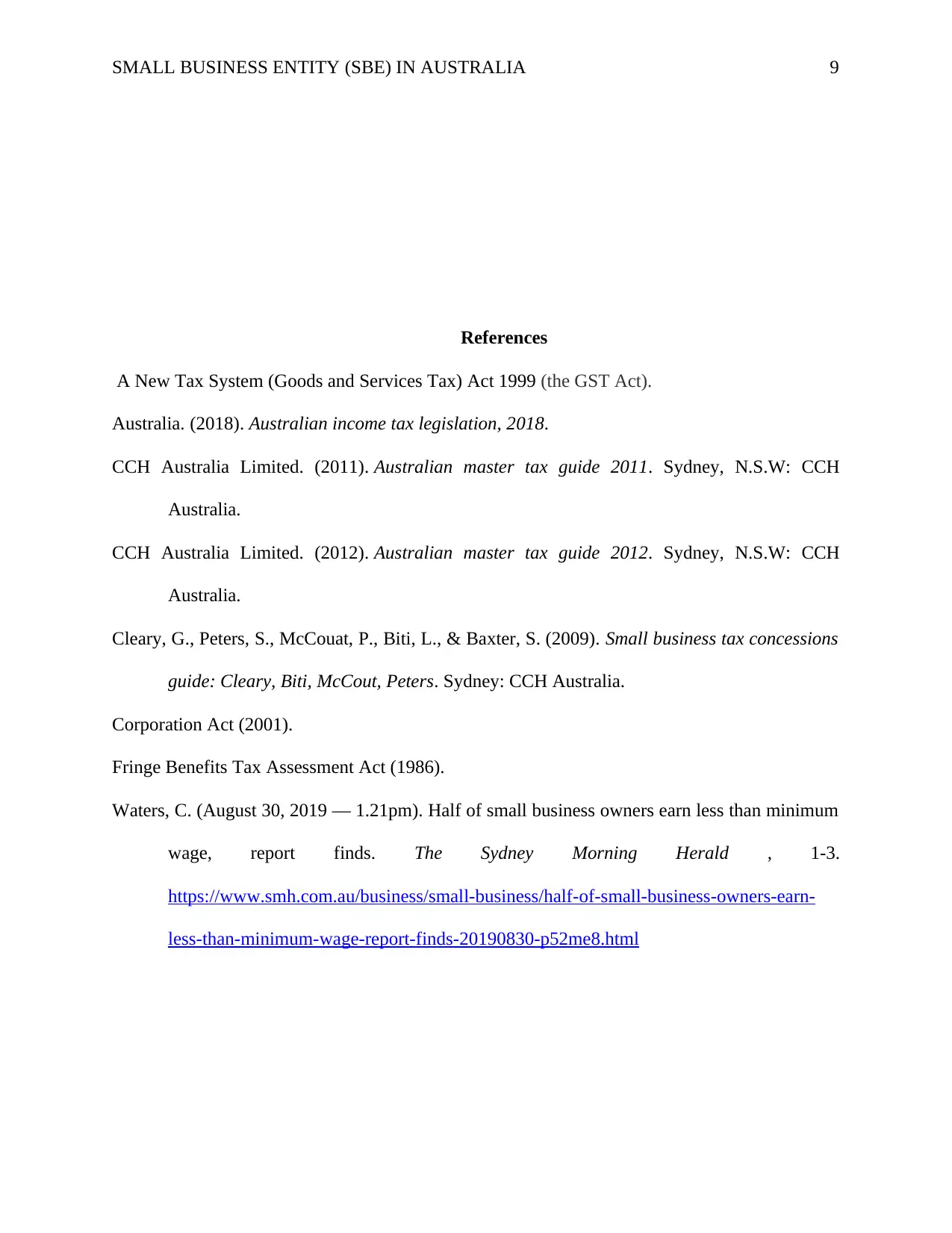
SMALL BUSINESS ENTITY (SBE) IN AUSTRALIA 9
References
A New Tax System (Goods and Services Tax) Act 1999 (the GST Act).
Australia. (2018). Australian income tax legislation, 2018.
CCH Australia Limited. (2011). Australian master tax guide 2011. Sydney, N.S.W: CCH
Australia.
CCH Australia Limited. (2012). Australian master tax guide 2012. Sydney, N.S.W: CCH
Australia.
Cleary, G., Peters, S., McCouat, P., Biti, L., & Baxter, S. (2009). Small business tax concessions
guide: Cleary, Biti, McCout, Peters. Sydney: CCH Australia.
Corporation Act (2001).
Fringe Benefits Tax Assessment Act (1986).
Waters, C. (August 30, 2019 — 1.21pm). Half of small business owners earn less than minimum
wage, report finds. The Sydney Morning Herald , 1-3.
https://www.smh.com.au/business/small-business/half-of-small-business-owners-earn-
less-than-minimum-wage-report-finds-20190830-p52me8.html
References
A New Tax System (Goods and Services Tax) Act 1999 (the GST Act).
Australia. (2018). Australian income tax legislation, 2018.
CCH Australia Limited. (2011). Australian master tax guide 2011. Sydney, N.S.W: CCH
Australia.
CCH Australia Limited. (2012). Australian master tax guide 2012. Sydney, N.S.W: CCH
Australia.
Cleary, G., Peters, S., McCouat, P., Biti, L., & Baxter, S. (2009). Small business tax concessions
guide: Cleary, Biti, McCout, Peters. Sydney: CCH Australia.
Corporation Act (2001).
Fringe Benefits Tax Assessment Act (1986).
Waters, C. (August 30, 2019 — 1.21pm). Half of small business owners earn less than minimum
wage, report finds. The Sydney Morning Herald , 1-3.
https://www.smh.com.au/business/small-business/half-of-small-business-owners-earn-
less-than-minimum-wage-report-finds-20190830-p52me8.html
⊘ This is a preview!⊘
Do you want full access?
Subscribe today to unlock all pages.

Trusted by 1+ million students worldwide
1 out of 9
Related Documents
Your All-in-One AI-Powered Toolkit for Academic Success.
+13062052269
info@desklib.com
Available 24*7 on WhatsApp / Email
![[object Object]](/_next/static/media/star-bottom.7253800d.svg)
Unlock your academic potential
Copyright © 2020–2025 A2Z Services. All Rights Reserved. Developed and managed by ZUCOL.





